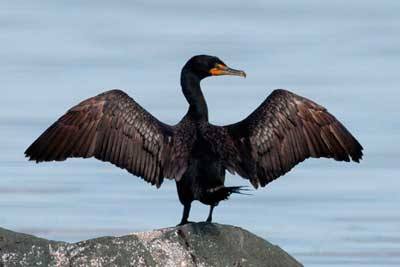By Peggy Butler, special to the Journal
Did you see them?
They have little pinkish throat sacs on long, narrow necks. The long beak strains upward—begging, begging.
The baby cormorants engage in a fascinating food dance—an exhibition you may have noticed while onboard the ferry at the Anacortes terminal. You’ve noticed the black, long necked cormorants standing guard over the nests, or scouting for fish. Many also sit in the cramped, muddy—and very smelly—nests where one, two or three babies relentlessly beg for food.
These little ones work hard to get fed. This is a joint effort.
Besides the energetic nodding upwards without ceasing, they must convince mom or dad to open their mouths. They do it this way: they rub their beak along the parent’s beak continuously looking for a way inside. Mom or dad also continuously move the target beak.
It’s almost like two swords trying to find each other’s point. No wonder they have such long necks.
Every bird in the cramped space seems to be moving all the time, so it’s not an easy task. If an adult opens wide—very, very wide—the baby places his beak and head all the way inside the adult’s throat and gulps the needed nourishment, it’s small pink throat sac vibrating with the intake.
This complicated process plays out all day long. Some nests appear to have only one chick while I saw a nest with three chicks and one adult attempting to divide the food—evenly?
The older chicks are darker colored while the younger nestlings are covered with gray down.
The stash of fish inside the cormorant has been mined by humans for over a thousand years.
In Japan, “Fishing Masters” on the Nagara River continue an important tradition, using cormorants to catch fish. People come from all over the world to watch this event.
The masters place a ring around the cormorants neck leaving enough space to swallow small fish, but creating a bottleneck for the larger catch. When the cormorants return from fishing, the keepers remove the larger fish to feed their own children.
Read more at: http://en.wikipedia.org/wiki/Cormorant_Fishing_on_the_Nagara_River
This is an example of being at the top of the food chain, a position much appreciated by the small human fledglings awaiting a high protein meal.
Usually the potent smell from the cormorant colony makes me want to turn my head away, but this nesting season the drama of cormorant nursing was a first class live display of amazing nature.



